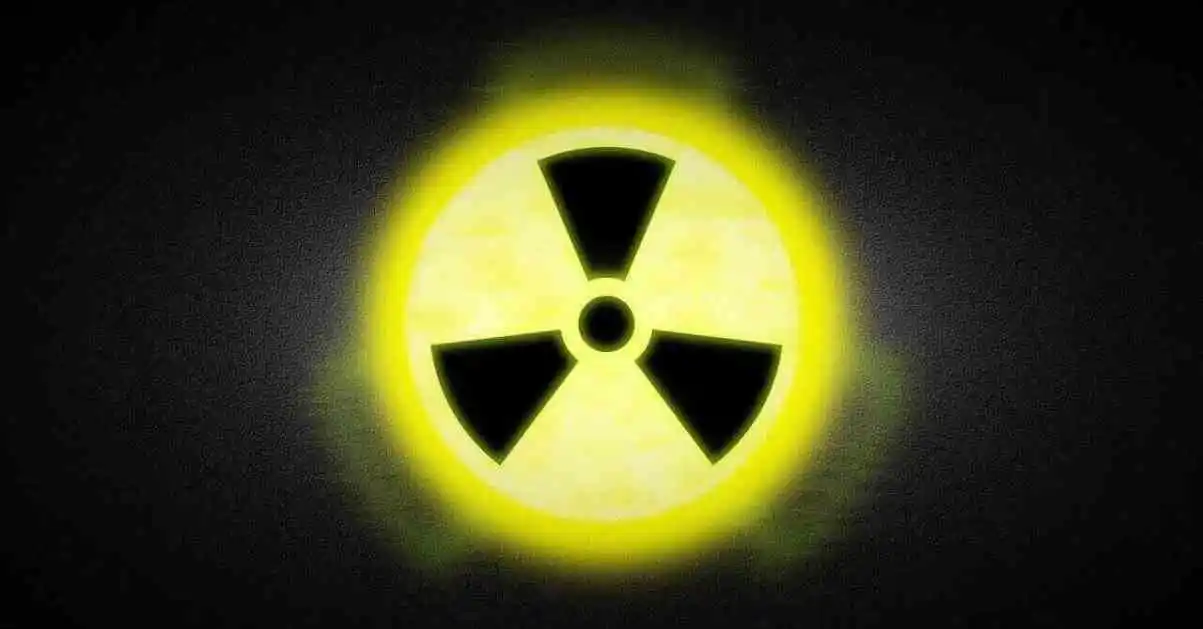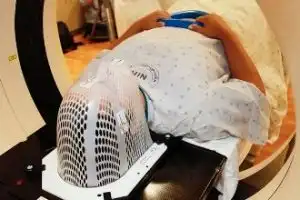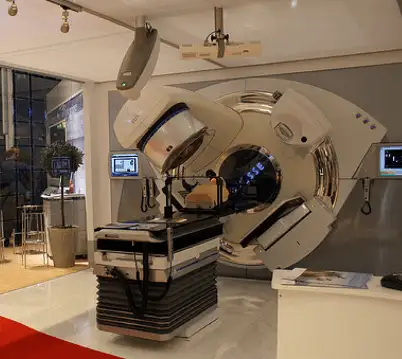
Radiation Treatment
Radiation Therapy to Treat Cancer
Table of Contents
Radiation Therapy to Treat Cancer
The use of high-energy radiation from x-rays, gamma rays, neutrons, protons, and other sources to kill cancer cells and shrink tumors. Radiation may come from a machine outside the body (external-beam radiation therapy), or it may come from radioactive material placed in the body near cancer cells (internal radiation therapy or brachytherapy). Systemic radiotherapy uses a radioactive substance, such as a radiolabeled monoclonal antibody, that travels in the blood to tissues throughout the body. Also called irradiation and radiation therapy.
Read the full article on the National Cancer Institute website.
Dangers of Radiation treatment

Source: Accuray (manufacturer of radiation therapy equipment)
Important Safety Statement: Most side effects of radiotherapy, including radiotherapy delivered with Accuray systems, are mild and temporary, often involving fatigue, nausea, and skin irritation. Side effects can be severe, however, leading to pain, alterations in normal body functions (for example, urinary or salivary function), deterioration of quality of life, permanent injury and even death.
Radiation therapy to the chest can cause:
Source: Leukemia and Lymphoma Society
- Lung damage (scarring, inflammation, breathing difficulties)
- Heart damage (scarring, inflammation, coronary heart disease)
- Osteosarcoma (bone cancer)
- Breast cancer
- Thyroid cancer
- Hypothyroidism or hyperthyroidism
Radiation therapy may double the incidence of solid cancers
Study: Intensity-modulated radiation therapy (IMRT) allows dose to be concentrated in the tumor volume while sparing normal tissues. However, the downside to IMRT is the potential to increase the number of radiation-induced second cancers…
…Intensity-modulated radiation therapy may double the incidence of solid cancers in long-term survivors.
In this study published in the journal Cancer July 1st, 2012, researchers from the Department of Radiation Oncology at the UCLA Jonsson Comprehensive Cancer Center report that radiation treatment transforms cancer cells into treatment‐resistant breast cancer stem cells, even as it kills half of all tumor cells.
Radiation increases cancer
This study done at UCLA Jonsson Comprehensive Cancer Center found radiation actually induces breast cancer cells to form more tumors. Plus, malignancy in radiation treated breast cells was likely to be 30 times more probable. Radiation actually promotes malignancy in cancer cells instead of killing them, and it allows cancers to grow back with even greater force.
Cure worse than the disease
Study of 35,958 survivors of Head and Neck cancer (72% had undergone radiation) concluded:
Many long-term HNSCC [head and neck squamous cell carcinoma] survivors die from cancers other than HNSCC and from non-cancer causes.
[Note: For patients who survived at least three years from a diagnosis of HNSCC, secondary cancers and cardiovascular issues killed 44% of these patients as opposed to only 29% who died from the actual cancer. In other words, the cure is worse than the disease]
Radiation treatment generates therapy-resistant cancer stem cells from less aggressive breast cancer cells
Source: Wiley Online Library
Researchers from the Department of Radiation Oncology at the UCLA Jonsson Comprehensive Cancer Center report that radiation treatment transforms cancer cells into treatment-resistant breast cancer stem cells, even as it kills half of all tumor cells.1
“When we look at early-stage cancer patients, we compare patients receiving exactly the same treatment, and some fail and some are cured, and we can’t predict who those patients will be,” says Frank Pajonk, MD, PhD, the study’s senior author and an associate professor of radiation oncology and Jonsson Cancer Center researcher.
In some cases, cancer stem cells are generated by the therapy, but scientists do not yet understand all the mechanisms that cause this to occur. If they can determine the pathway and remove the reprogramming of cancer cells, they ultimately may be able to reduce the amount of radiation given to patients along with its accompanying side effects, says Dr. Pajonk.
The investigators found that induced breast cancer stem cells (iBCSCs) were generated by radiation-induced activation of the same cellular pathways used to reprogram normal cells into induced pluripotent stem cells in regenerative medicine.
In the study, Dr. Pajonk and colleagues eliminated the smaller pool of BCSCs and then irradiated the remaining breast cancer cells and put them in mice. They were able to observe the initial generation into iBCSCs in response to the radiation treatment through a unique imaging system. These new cells were highly similar to the BCSCs that had been found in tumors that had not been irradiated. They also found that these iBCSCs had a more than 30-fold increased ability to form tumors than the nonirradiated breast cancer cells.
Their findings show that if tumors are challenged by certain stressors that threaten them (such as radiation), they generate iBCSCs that may, along with surviving cancer stem cells, produce more tumors.
The researchers’ work continues as they begin to identify the pathways and several classes of drugs to prevent this process from occurring. To date, they have identified 2 different targets and drugs that could prevent it. The group has published their results of the study in breast cancer but also has made similar observations in both glioblastoma and head and neck cancer.
Dr. Pajonk says the study does not discredit radiation therapy. “Patients come to me scared by the idea that radiation generates these cells, but it truly is the safest and most effective therapy there is.”
1 Lagadec, C, Vlashi, E, Della Donna, L, Dekmezian, C, Pajonk, F. Radiation-induced reprogramming of breast cancer cells. Stem Cells. 2012;30:833–844.
Breast irradiation causes breast and lung cancer
Young women treated with radiotherapy for Hodgkin’s disease (HD) experienced a threefold increased risk of breast cancer, which rose with higher radiation doses to the breast. HD patients treated with radiotherapy had a sixfold risk of lung cancer, with risk related to dose of radiation received.
Women who received pelvic radiotherapy for cervical cancer were found to have a twofold risk of new cancers in organs that were heavily irradiated.
Source: Second Cancers – Landmark Studies
The Surveillance, Epidemiology, and End Results (SEER) Program of the National Cancer Institute
Study: Radiation Therapy Can Make Cancers 30x More Malignant
Written By: Sayer Ji, Founder

Following on the heels of recent revelations that x-ray mammography may be contributing to an epidemic of future radiation-induced breast cancers, in a new article titled, “Radiation Treatment Generates Therapy Resistant Cancer Stem Cells From Aggressive Breast Cancer Cells,” published in the journal Cancer July 1st, 2012, researchers from the Department of Radiation Oncology at the UCLA Jonsson Comprehensive Cancer Center report that radiation treatment actually drives breast cancer cells into greater malignancy.
The researchers found that even when radiation kills half of the tumor cells treated, the surviving cells which are resistant to treatment, known as induced breast cancer stem cells (iBCSCs), were up to 30 times more likely to form tumors than the nonirradiated breast cancer cells. In other words, the radiation treatment regresses the total population of cancer cells, generating the false appearance that the treatment is working, but actually increases the ratio of highly malignant to benign cells within that tumor, eventually leading to the iatrogenic (treatment-induced) death of the patient.
Last month, a related study published in the journal Stem Cells titled, “Radiation-induced reprogramming of breast cells,” found that ionizing radiation reprogrammed less malignant (more differentiated) breast cancer cells into iBCSCs, helping to explain why conventional treatment actually enriches the tumor population with higher levels of treatment-resistant cells. [i]
A growing body of research now indicts conventional cancer treatment with chemotherapy and radiation as a major contributing cause of cancer patient mortality. The primary reason for this is the fact that cancer stem cells, which are almost exclusively resistant to conventional treatment, are not being targeted, but to the contrary, are encouraged to thrive when exposed to chemotherapy and radiotherapy.
In order to understand how conventional treatment drives the cancer into greater malignancy, we must first understand what cancer is….
What Are Cancer Stem Cells, And Why Are They Resistant To Treatment?
Tumors are actually highly organized assemblages of cells, which are surprisingly well-coordinated for cells that are supposed to be the result of strictly random mutation. They are capable of building their own blood supply (angiogenesis), are able to defend themselves by silencing cancer-suppression genes, secreting corrosive enzymes to move freely throughout the body, alter their metabolism to live in low oxygen and acidic environments, and know how to remove their own surface-receptor proteins to escape detection by white blood cells. In a previous article titled “Is Cancer An Ancient Survival Program Unmasked?” we delved deeper into this emerging view of cancer as an evolutionary throw-back and not a byproduct of strictly random mutation.
Because tumors are not simply the result of one or more mutated cells “going rogue” and producing exact clones of itself (multi-mutational and clonal hypotheses), but are a diverse group of cells having radically different phenotypal characteristics, chemotherapy and radiation will affect each cell type differently.
Tumors are composed of a wide range of cells, many of which are entirely benign.
The most deadly cell type within a tumor or blood cancer, known as cancer stem cells (CSCs), has the ability to give rise to all the cell types found within that cancer.
They are capable of dividing by mitosis to form either two stem cells (increasing the size of the stem population), or one daughter cell that goes on to differentiate into a variety of cell types, and one daughter cell that retains stem-cell properties.
This means CSCs are tumorigenic (tumor-forming) and should be the primary target of cancer treatment because they are capable of both initiating and sustaining cancer. They are also increasingly recognized to be the cause of relapse and metastasis following conventional treatment.
CSCs are exceptionally resistant to conventional treatment for the following reasons
- CSCs account for less than 1 in 10,000 cells within a particular cancer, making them difficult to destroy without destroying the vast majority of other cells comprising the tumor.[ii]
- CSCs are slow to replicate, making them less likely to be destroyed by chemotherapy and radiation treatments that target cells which are more rapidly dividing.
- Conventional chemotherapies target differentiated and differentiating cells, which form the bulk of the tumor, but these are unable to generate new cells like the CSCs which are undifferentiated.
The existence of CSCs explains why conventional cancer treatment has completely missed the boat when it comes to targeting the root cause of tumors. One reason for this is because existing cancer treatments have mostly been developed in animal models where the goal is to shrink a tumor. Because mice are most often used and their life spans do not exceed two years, tumor relapse is very difficult, if not impossible to study.
The first round of chemotherapy never kills the entire tumor, but only a percentage. This phenomenon is called the fractional kill. The goal is to use repeated treatment cycles (usually six) to regress the tumor population down to zero, without killing the patient.
What normally occurs is that the treatment selectively kills the less harmful populations of cells (daughter cells), increasing the ratio of CSCs to benign and/or less malignant cells. This is not unlike what happens when antibiotics are used to treat certain infections. The drug may wipe out 99.9% of the target bacteria, but .1% have or develop resistance to the agent, enabling the .1% to come back even stronger with time.
The antibiotic, also, kills the other beneficial bacteria that help the body fight infection naturally, in the same way that chemotherapy kills the patient’s immune system (white blood cells and bone marrow), ultimately supporting the underlying conditions making disease recurrence more likely.
The reality is that the chemotherapy, even though it has reduced the tumor volume, by increasing the ratio of CSCs to benign daughter cells, has actually made the cancer more malignant.
Radiotherapy has also been shown to increase cancer stem cells in the prostate, ultimately resulting in cancer recurrence and worsened prognosis.[iii] Cancer stem cells may also explain why castration therapy often fails in prostate cancer treatment.[iv]
Non-Toxic Natural Substances Which Target and Kill CSCs
Natural compounds have been shown to exhibit three properties which make them suitable alternatives to conventional chemotherapy and radiotherapy:
- High margin of safety: Relative to chemotherapy agents such as 5-fluorouracil natural compounds are two orders of magnitude safer
- Selective Cytotoxicity: The ability to target only those cells that are cancerous and not healthy cells
- CSCs Targeting: The ability to target the cancer stem cells within a tumor population.
The primary reason why these substances are not used in conventional treatment is because they are not patentable, nor profitable. Sadly, the criteria for drug selection are not safety, effectiveness, accessibility and affordability. If this were so, natural compounds would form an integral part of the standard of care in modern cancer treatment.
Research indicates that the following compounds (along with common dietary sources) have the ability to target CSCs:
- Curcumin (Turmeric)
- Resveratrol (Red Wine; Japanese Knotweed)
- Quercetin (Onion)
- Sulforaphane (Brocolli sprouts)
- Parthenolide (Butterbur)
- Andrographalide (Andrographis)
- Genistein (Cultured Soy; Coffee)
- Piperine (Black Pepper)

Sayer Ji is founder of Greenmedinfo.com, a reviewer at the International Journal of Human Nutrition and Functional Medicine, Co-founder and CEO of Systome Biomed, Vice Chairman of the Board of the National Health Federation, Steering Committee Member of the Global Non-GMO Foundation.
Disclaimer: This article is not intended to provide medical advice, diagnosis or treatment. Views expressed here do not necessarily reflect those of GreenMedInfo or its staff.
Article © [2012] GreenMedInfo LLC. This work is reproduced and distributed with the permission of GreenMedInfo LLC. Want to learn more from GreenMedInfo? Sign up for the newsletter here http://www.greenmedinfo.com/greenmed/newsletter.
See also:
Reduce Radiation side effects
Vital questions to ask your doctor about radiation treatment
Updated 2024
